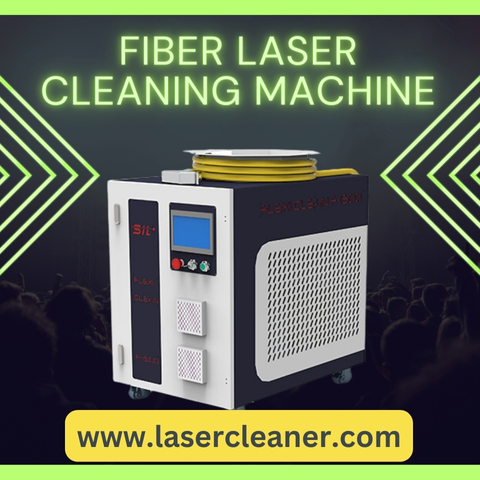
In industrial cleaning, precision and efficiency are two elements that determine the success of any process. Traditional cleaning methods, such as sandblasting, chemical cleaning, and abrasive techniques, have served their purpose for decades. However, the growing need for faster, safer, and environmentally responsible cleaning solutions has given rise to new technology. Among these, the fiber laser cleaning machine has become one of the most reliable options. It is widely adopted across different industries for its ability to remove rust, paint, oil, grease, and other surface contaminants without damaging the base material.
This guide explores the role of the fiber laser cleaning machine, how it works, where it is applied, and why it is considered one of the most effective solutions in modern industries. In this guide, we will also look at the operational methods, the industries benefiting the most, and the results it delivers.
Understanding the Fiber Laser Cleaning Machine
A fiber laser cleaning machine is designed to use concentrated laser energy for cleaning surfaces. Instead of using physical contact or chemical reactions, it projects a high-energy laser beam directly on the target surface. The contaminants, such as rust, paint, or oxide layers, absorb the laser energy. This energy causes them to evaporate, burn off, or detach, leaving the underlying surface intact and clean.
Unlike conventional cleaning techniques, the fiber laser cleaning machine operates with precision. It is capable of selective cleaning, meaning it can remove unwanted layers without disturbing the base material. This makes it particularly useful for delicate components, expensive machinery, and surfaces where material integrity is critical.
How the Fiber Laser Cleaning Machine Works
The working process of a fiber laser cleaning machine involves several steps:
-
Laser Emission
A fiber laser generates a high-intensity beam that is directed onto the surface through a handheld or automated system. -
Absorption of Energy
The contaminants on the surface absorb the laser energy differently compared to the base material. This selective absorption allows the laser to target only the rust, paint, or coating. -
Removal of Contaminants
Once absorbed, the contaminants heat up rapidly and either vaporize or break away from the material. -
Surface Exposure
After the contaminants are removed, the clean base surface remains intact, ready for further processing such as welding, painting, or coating.
This process is highly efficient because it is non-contact, which eliminates mechanical stress and minimizes wear on the equipment.
Applications of Fiber Laser Cleaning Machine
The fiber laser cleaning machine is used in many industries because of its wide range of cleaning capabilities. Some of the main applications include:
-
Rust Removal
Rust is one of the most common issues faced by industries dealing with metals. The fiber laser cleaning machine can effectively remove rust without damaging the underlying steel or iron. -
Paint Removal
In industries such as automotive and aerospace, removing old paint layers before recoating is critical. Laser cleaning offers a controlled method for paint removal. -
Welding Preparation and Post-Weld Cleaning
Before welding, metals must be free from contaminants. After welding, residues such as oxides need to be removed. The fiber laser cleaning machine is used in both stages to ensure high-quality welding results. -
Cultural Heritage and Restoration
Historical monuments, sculptures, and artifacts often require cleaning without damage. The selective action of laser cleaning makes it suitable for such delicate applications. -
Electronics Industry
Circuit boards and electronic components often need precise cleaning. Laser technology allows contamination removal without harming the sensitive materials.
Benefits in Industrial Settings
The adoption of the fiber laser cleaning machine in industries is increasing because it provides a faster, cleaner, and safer way to prepare surfaces. It reduces dependency on chemicals, lowers maintenance needs, and saves time in production cycles. Since the technology is flexible, it can be integrated into manual systems or automated assembly lines.
Why Industries Choose Fiber Laser Cleaning Machine
Industries require solutions that can balance efficiency with operational safety. A fiber laser cleaning machine offers this balance because it delivers accurate results, reduces waste, and operates in a controlled manner. The reduced environmental footprint and long-term cost savings also make it a preferred choice. From large manufacturing units to small workshops, this machine has shown adaptability across different scales of operation.
Future Outlook of Fiber Laser Cleaning Machine
As industries continue to demand sustainable and efficient cleaning methods, the future of the fiber laser cleaning machine looks strong. The technology is advancing with higher power lasers, improved mobility, and smarter automation. With these improvements, the machine will find more applications in aerospace, shipbuilding, automotive, power generation, and even medical equipment maintenance.
Final Thoughts
The fiber laser cleaning machine has transformed the way industries approach surface preparation and cleaning. Its ability to remove rust, paint, and contaminants without damaging the base material makes it suitable for critical applications. With rising demand for efficient, eco-friendly, and precise solutions, this machine is becoming a standard tool across manufacturing, automotive, aerospace, and cultural preservation sectors. By replacing traditional methods, it provides industries with a reliable cleaning solution that aligns with modern operational needs.



